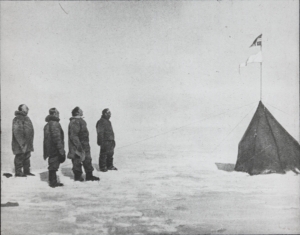Amundsen's tentFish glue is what Amundsen called the abrasive snow we have been fighting against all day. It’s almost like skiing in sand, and over ten full hours of active skiing resulted in a disappointing 27 km. It has also snowed a bit today, a rare occurrence on the plateau. In these parts the total yearly precipitation is about 50 mm.
“−28°. Breeze from the south and crystal clear. It has been a little cool to go up wind, but nothing to make a fuss over. ”– Amundsen on this day 100 years ago (Read more …) 
Despite the low yearly precipitation, the extra tent Amundsen left behind is believed to be at about 15-18 metres depth. No more snow than that has accumulated in these 100 years. This is a polar desert. If you want to search for the tent, you can’t simply start digging at exactly 90 degrees south. The navigation instruments used in Amundsen’s day were sextant, chronometer, compass and surveyor’s wheel. A Norwegian professor later calculated that Amundsen’s navigation had a precision of three kilometres. So if you intend to dig randomly within a radius of three kilometres, you may be obliged to shovel several hundred million cubic metres of snow to locate the tent. Some help may be available, however. The tent still contains the box that held the letter with the famous words from Amundsen to Scott: “Dear Captain Scott – As you probably are the first to reach this area after us, I will ask you to kindly forward this letter to King Haakon VII. If you can use any of the articles left in the tent please do not hesitate to do so. With kind regards, and a wish for your safe return. Yours truly, Roald Amundsen” This box might give a reflection if you search with radar. But the next obstacle is that when the American Amundsen–Scott base was being constructed in 1957, much of the equipment was airlifted in and dropped. Many of the items that were dropped were never found by the ground crew. In other words, the area is full of objects that might reflect radar waves. Talk about looking for a needle in a haystack... In 2005 the nations that are party to the Antarctic Treaty decided to protect Amundsen’s tent. The 100-year jubilee was approaching and plans were being made to excavate the tent. Norway suggested that it be protected and all the other nations were in favour. An extensive excavation project that perturbed research at the station would have been particularly unfavourable for the United States, which runs the Amundsen–Scott station. Thus Roald Amundsen’s tent has been declared a cultural heritage site and can continue its protected, peaceful, slow and chilly journey to ever greater ice depths. Position: S 88 17.464, E 178 09.188
Temperature: -22°C morning, -29°C evening Wind: Calm Elevation: 3140 metres Distance traversed: 27 km Distance behind Amundsen: 31 km Total distance traversed: 1120 km Distance remaining to the South Pole: 191 km Did you know that the leopard seal is a dreaded predator in Antarctica?
Leopard seals are probably the penguin’s worse enemies. |
South Pole 1911–2011 is an informational outreach project run by the Norwegian Polar Institute
Contact person:


